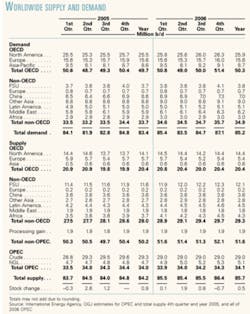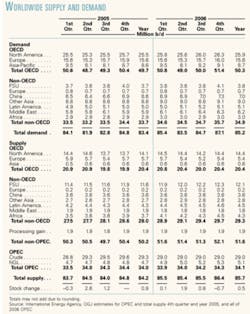Given current oil demand projections, key members of the Organization of Petroleum Exporting Countries will need to reduce output to avoid oversupplying the market in the short run as non-OPEC supply grows.
Worldwide oil demand will grow 1.79 million b/d this year, according to the International Energy Agency, with the majority of the increase in countries outside the Organization for Economic Cooperation and Development (OECD). The Paris-based agency also projects that in 2006, non-OPEC oil supply will increase 1.4 million b/d and OPEC production of other liquids will climb 350,000 b/d.
But with a view to the world’s need for oil in the long run, OPEC production capacity expansions are moving ahead.
Oil demand
Oil demand in OECD nations will grow to 50.3 million b/d this year, an increase of 570,000 b/d. This compares to growth last year of 240,000 b/d.
Oil demand in Europe will be unchanged from last year, but increases are forecast in Mexico, Canada, Japan, South Korea, and the US. IEA expects US oil demand to grow to 21.17 million b/d this year from 20.81 million b/d.
Outside the OECD, total oil demand will climb 1.22 million b/d. Leading this increase will be China, where demand will move up to 7.03 million b/d from 6.63 million b/d last year. IEA figures show that last year, Chinese oil demand grew an average of 200,000 b/d, following a 2004 surge in demand of 850,000 b/d.
Elsewhere, moderate growth in demand is expected in the Former Soviet Union, India, and Latin America. IEA forecasts that oil demand this year will climb to 6.23 million b/d from 5.92 million b/d in the Middle East and to 2.99 million b/d from 2.9 million b/d in Africa.
Oil supply
Total non-OPEC oil supply this year will increase to 51.6 million b/d.
OECD output will be unchanged, as a 300,000 b/d increase in North American supply is offset by an equal decline in Europe, and OECD Asian production is steady from last year.
Meanwhile, non-OECD and non-OPEC supply will grow 1.3 million b/d this year. FSU oil supply will be up 500,000 b/d to 12.1 million b/d, with more modest increases in Latin America and Asia. Non-OPEC Middle East production is forecast to decline 100,000 b/d, while non-OECD supply from Europe and Chinese supply will remain unchanged.
Leading the surge in non-OECD oil supply growth this year will be Africa. IEA figures indicate that non-OPEC African production will grow to 4.3 million b/d from 3.7 million b/d last year. Leading this growth is Angola, following startup of ExxonMobil Corp.’s Kizomba A and B projects, as well as its Xikomba production that came online in late 2003 (OGJ, Oct. 10, 2005, p. 44).
A recent research report issued by Deutsche Bank Securities Inc. said that waters off Angola are still greatly underexplored compared with the Gulf of Mexico. The Angolan government is accommodating, but there are growing challenges to exploration there, such as deepwater costs, rig availability, fiscal terms in a seller’s market, and attention to exploration in China.
In spite of these risks, Deutsche Bank said Angolan production will account for 16% of projected global production growth and 26% of growth in non-OPEC nations over the next 5 years.
OPEC supply
Using current demand projections, OGJ forecasts that inventories will build by an average of 500,000 b/d for the year if OPEC holds its 2006 crude output steady at 29 million b/d. This would be a drop in crude output from an average of 29.5 million b/d last year.
OPEC’s supply of natural gas liquids has been growing steadily in recent years, averaging 3.9 million b/d in 2003, then 4.3 million b/d in 2004, and 4.7 million b/d last year. IEA forecasts that this supply, which is not figured into the organization’s production ceiling, will grow to average 5.1 million b/d this year.
While supplies of oil do not appear to be tight in 2006, OPEC is taking steps to boost its production capacity to meet future demand growth. Member countries, in some cases in conjunction with international oil companies, are implementing investment plans to increase crude production capacity to at least 38 million b/d by 2010, up from the current capacity of about 33 million b/d.
OPEC says that in 2006, capacity expansions are expected in almost every member country, but the bulk will take place in Algeria, Iran, Libya, Nigeria, Saudi Arabia, and the UAE. Of the 18 projects representing over $15 billion in new investments, a dozen will produce light crude and six medium-quality crude, the organization announced.✦

